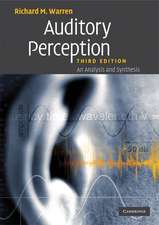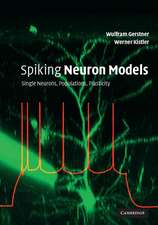Glial Cells: Their Role in Behaviour
Editat de Peter R. Laming, Eva Syková, Andreas Reichenbach, Glenn I. Hatton, Herbert Baueren Limba Engleză Paperback – 16 feb 2011
Preț: 432.86 lei
Nou
Puncte Express: 649
Preț estimativ în valută:
82.85€ • 86.17$ • 69.43£
82.85€ • 86.17$ • 69.43£
Carte tipărită la comandă
Livrare economică 14-28 martie
Preluare comenzi: 021 569.72.76
Specificații
ISBN-13: 9780521183826
ISBN-10: 0521183820
Pagini: 446
Dimensiuni: 178 x 254 x 23 mm
Greutate: 0.77 kg
Editura: Cambridge University Press
Colecția Cambridge University Press
Locul publicării:New York, United States
ISBN-10: 0521183820
Pagini: 446
Dimensiuni: 178 x 254 x 23 mm
Greutate: 0.77 kg
Editura: Cambridge University Press
Colecția Cambridge University Press
Locul publicării:New York, United States
Cuprins
Preface; 1. Changing concepts on the role of glia Peter Laming; 2. The phylogeny of glial–neuronal relationships and behaviour Betty Roots and Peter Laming; 3. Glial cells in brain development and plasticity Christian Müller; 4. The retina as a model of glial function in the brain Andreas Reichenbach, Serguei N. Skatchkov and Winfried Reichelt; 5. Metabolic trafficking between neurons and glia Stephen R. Robinson, Arne Schousboe, Ralf Dringen, Pierre Magistretti, Jonathan Coles and Leif Hertz; 6. Transmitter receptor and uptake systems in astrocytes and their relation to behaviour Harold K. Kimelberg, Tuula O. Jalonen, Chiye Aoki and Ken McCarthy; 7. Glial regulation of the neuronal microenvironment Eva Sykova, Elisabeth Hansson, Lars Rönnbäck and Charles Nicholson; 8. Role of periaxonal glia in nerve conduction Joan Abbott; 9. Transplantation of myelin-forming glial cells into the spinal cord: restoration of normal conduction in previously demyelinated axons Jeffery D. Kocsis and Stephen G. Waxman; 10. Contributions of potassium currents and glia to slow potential shifts Uwe Heinemann and Wolfgang Walz; 11. Acid alkaline transients and pH regulation glia Joachim Deitmer; 12. Intra-cranial slow potential shifts and behavioural state Peter Laming, Alister Nichol and John Roughan; 13. Slow brain potentials, sensory processing and cognition Herbert Bauer, Niels Birbaumer and Frank Roesler; 14. Recent evidence from around the brain for structural plasticity of astrocytes in the adult CNS Adrienne Salm, N. Hawrylak, J. B. Bobak, G. I. Hatton and C. Aoki; 15. Astrocytic involvement in learning Kim Ng, Ciaran Regan and Brona O'Dowd; References; Index.
Recenzii
Review of the hardback: ' … a very useful book for a neurobiologist's library'. Bernhard H. J. Juurlink, TINS
Review of the hardback: 'This is a challenging, but overall, very good book.' Brain
Review of the hardback: 'This is a challenging, but overall, very good book.' Brain
Descriere
This 1998 book discusses how neurons and glial cells interact with each other to influence behaviour.









